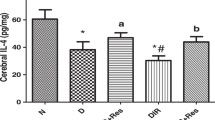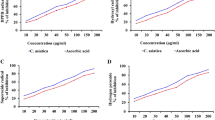Abstract
Oxidative stress and inflammation have been implicated in cerebral ischemia/reperfusion injury and complication of diabetes. The present study was designed to evaluate whether resveratrol has cerebroprotective action through antioxidant and anti-inflammatory actions in diabetic rats. Bilateral common carotid artery occlusion (30 min) and reperfusion (4 h) was employed to induce cerebral infarction in diabetic Wistar rats. Diabetes was induced by streptozocine (50 mg/kg) intraperitoneally at once. Diabetic animals were divided into groups as: normal, sham, ischemia–reperfusion, and resveratrol-treated (5, 10, 20, and 30 mg/kg). These were used for estimation of cerebral infarction. Furthermore, 20 mg/kg dose was selected for estimation of oxidative stress markers (malondialdehyde, superoxide dismutase, and catalase). Inflammatory markers like TNF-α, IL-6, IL-10, and myeloperoxidase were estimated and histological characters were studied. Resveratrol produced dose-dependent reduction in percent cerebral infarction. With resveratrol of 20 mg/kg dose, levels of oxidative stress markers and inflammatory markers like malondialdehyde, TNF-α, IL-6, and myeloperoxidase were reduced and there was a significant increase in the levels of antioxidant and anti-inflammatory markers like catalase, superoxide dismutase, and IL-10. In the present study, we found that mechanism(s) responsible for the cerebroprotective effect of resveratrol in the diabetic rat brain involves antioxidant and anti-inflammatory actions.

Similar content being viewed by others
References
Aebi H (1974) Catalase. In: Bergmer HU (ed) Methods in enzymatic analysis, vol 2. Academic, New York, pp 673–684
Aggarwal BB, Bhardwai A, Aggarwal RS et al (2004) Role of resveratrol in prevention and therapy of cancer: preclinical and clinical studies. Anticancer Res 24:2783–40
Andrabi SA, Spina MG, Lorenz P et al (2004) Oxyresveratrol (trans-2, 3′, 4,5′-tetrahydroxystilbene) is neuroprotective and inhibits the apoptotic cell death in transient cerebral ischemia. Brain Res 1017:98–7
Canbaz S, Duran E (2003) Ischaemia–reperfusion studies and diabetes mellitus. Br J Anaesth 91:158–159
Dawn B (2007) Resveratrol: ready for prime time? J Mol Cell Cardiol 42:484–486
de la Lastra CA, Villegas I (2007) Resveratrol as an antioxidant and pro-oxidant agent: mechanisms and clinical implications. Biochem Soc Trans 35:1156–1160
Del Zoppo GJ (1997) Microvascular responses to cerebral ischemia/inflammation. Ann NY Acad Sci 823:132–147
Della-Morte D, Dave KR, DeFazio RA et al (2009) Resveratrol pretreatment protects rat brain from cerebral ischemic damage via a sirtuin 1-uncoupling protein 2 pathway. Neuroscience 159:993–1002
Di Carlo A (2009) Human and economic burden of stroke. Age Ageing 38:4–5
Gouwy M, Struyf S, Proost P, Van Damme J (2005) Synergy in cytokine and chemokine networks amplifies the inflammatory response. Cytokine Growth Factor Rev 16:561–580
Iwasaki Y, Ito S, Suzuki M, Nagahori T, Yamamato T, Konno H (1989) Forebrain ischemia induced by temporary bilateral common carotid occlusion in normotensive rats. J Neurol Sci 90:155–5
Juhasz B, Varga B, Gesztelyi R et al (2010) Resveratrol: a multifunctional cytoprotective molecule. Curr Pharm Biotechnol 11:810–818
Kakkar P, Das B, Viswanathan PN (1984) A modified spectrophotometric assay of superoxide dismutase. Ind J Bio Chem Biophys 21:130–132
Kaste M (1997) Current therapeutic options for brain ischemia. Neurology 49:s56–s59
Khan M, Siphon B, Jatana M, Giri S et al (2004) Administration of N-acetylcysteine after focal cerebral ischemia protects brain and reduces inflammation in a rat model of experimental stroke. J Neurosci Res 76:519–7
Kim HK (1997) Experimental models of cerebral ischemia. Acta Anaesthesiol Scand Suppl 111:91–92
Lakhan SE, Kirchgessner A, Hofer M (2009) Inflammatory mechanisms in ischemic stroke: therapeutic approaches. J Transl Med 7:97
Liu N, Chen R, Du H, Wang J, Zhang Y, Wen J (2009) Expression of IL-10 and TNF-alpha in rats with cerebral infarction after transplantation with mesenchymal stem cells. Cell Mol Immunol 6:207–213
Markus MA, Morris BJ (2008) Resveratrol in prevention and treatment of common clinical conditions of aging. Clin Interv Aging 2:331–339
Mukherjee PK, Ahamed KF, Kumar V, Mukherjee K, Houghton PJ (2007) Protective effect of biflavones from Araucaria bidwillii Hook in rat cerebral ischemia/reperfusion induced oxidative stress. Behav Brain Res 178:221–228
Mullane KM, Bruce Smith ND (1985) Myeloperoxidase activity as a quantitative assessment of neutrophil infiltration into ischemic myocardium. J Pharmacol Methods 14:157–7
Naylor AR (2011) Guidelines for the prevention of stroke in patients with stroke or transient ischemic attack: a guideline for healthcare professionals from the American Heart Association/American Stroke Association. Stroke 42:e385–e386
Okhawa H, Ohishi N, Yagi K (1979) Assay of lipid peroxides in animal tissue by thiobarbituric acid reaction. Anal Biochem 95:351–358
Orsu P, Murthy BV, Akula A (2013) Cerebroprotective potential of resveratrol through anti-oxidant and anti-inflammatory mechanisms in rats. J Neural Transm. doi:10.1007/s00702-013-0982-4
Rock RB, Gekker G, Hu S et al (2004) Role of microglia in central nervous system infections. Clin Microbiol Rev 17:942–964
Saito K, Suyama K, Nishida K, Sei Y, Basile AS (1996) Early increases in TNF-alpha, IL-6 and IL-1 beta following transient cerebral ischemia in gerbil brain. Neurosci Lett 206:149–2
Sinha K, Chaudhary G, Gupta YK (2002) Protective effect of resveratrol against oxidative stress in middle cerebral artery occlusion model of stroke in rats. Life Sci 71:655–665
Thirunavukkarasu M, Penumathsa SV, Koneru S, Juhasz B, Zhan L, Otani H et al (2007) Resveratrol alleviates cardiac dysfunction in streptozotocin-induced diabetes: Role of nitric oxide, thioredoxin, and heme oxygenase. Free Radic Biol Med 43:720–729
Tosaki A, Szerdahelyi P, Joo F (1994) Treatment with ranitidine of ischemic brain edema. Eur J Pharmacol 264:455–458
Tsuruta R, Fujita M, Ono T et al (2010) Hyperglycemia enhances excessive superoxide anion radical generation, oxidative stress, early inflammation, and endothelial injury in forebrain ischemia/reperfusion rats. Brain Res 1309:155–3
Wang Y, Schmeichel AM, Iida H, Schmelzer JD, Low PA (2005) Ischemia-reperfusion injury causes oxidative stress and apoptosis of Schwann cell in acute and chronic experimental diabetic neuropathy. Antioxid Redox Signal 7:1513–1520
Wong CH, Crack PJ (2008) Modulation of neuro-inflammation and vascular response by oxidative stress following cerebral ischemia–reperfusion injury. Curr Med Chem 15:1–14
Yasuda Y, Shimoda T, Uno K et al (2011) Temporal and sequential changes of glial cells and cytokine expression during neuronal degeneration after transient global ischemia in rats. J Neuroinflammation 8:70
Yousuf S, Atif F, Ahmad M et al (2007) Selenium plays a modulatory role against cerebral ischemia-induced neuronal damage in rat hippocampus. Brain Res 1147:218–225
Zhang F, Liu J, Shi JS (2010) Anti-inflammatory activities of resveratrol in the brain: role of resveratrol in microglial activation. Eur J Pharmacol 636:1–7
Acknowledgments
I am thankful to Prof A. Annapurna, Andhra University College of Pharmacy, Andhra University for giving valuable suggestions and support during the research work. I am also thankful to B.V.S.N Murthy, Sri Venkateswara College of Pharmacy, Srikakulam, for proving needs of research work.
Conflict of interest
None
Author information
Authors and Affiliations
Corresponding author
Rights and permissions
About this article
Cite this article
Prabhakar, O. Cerebroprotective effect of resveratrol through antioxidant and anti-inflammatory effects in diabetic rats. Naunyn-Schmiedeberg's Arch Pharmacol 386, 705–710 (2013). https://doi.org/10.1007/s00210-013-0871-2
Received:
Accepted:
Published:
Issue Date:
DOI: https://doi.org/10.1007/s00210-013-0871-2




